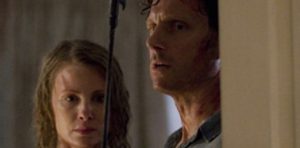 The Last House on the Left (2009 remake) ★★★½
The Last House on the Left (2009 remake) ★★★½
“Stomach-churningly anti-human” is the description given by the New York Daily News in its 2009 review of The Last House on the Left remake.
It’s a nice turn-of-phrase but also an hysterical one as there are dozens of horror films more fitting of such a description.
That includes Wes Craven’s original version of the same film released in 1972 amidst a torrent of controversy due to its prolonged scenes of sexual violence.
There are two reasons why Craven’s original worked so well. Firstly, the historical and societal context.
In 1972 Americans were still enduring several years of prime-time real television violence with daily coverage of the Vietnam War. By this stage people were sick of the mirror of inhumanity but Craven’s film not only brought violence onto the cinema screen; it also suggested that this could happen at any time to any family and questioned how we would react.
Secondly, Craven didn’t have a lot of money to make the film but he had a hell of a lot of talent. The result was a work that had even more impact because it almost looked like it could have been filming actual events.
And the acting was just good enough to strengthen the aesthetic that the budget look created, largely by design.
The 2009 remake, directed by Denis Iliadis and co-produced by Craven, is definitely a tough watch, but it doesn’t have quite the same impact. That’s not the fault of the actors, who all do good work in very challenging and potentially traumatic circumstances.
It’s purely a result of the comparison with the original and the fact that one of the results of having more money is that the film looks crisper and doesn’t look like it is completely detached from being, well, just a film.
The remake also had a fractured path to the screen. According to iMDB, Craven had wanted to add a supernatural element and that was reflected in the original script but later removed. A replacement writer felt the violence should be tempered by making one change.
But that change is a significant one in the context of the original story. Why Craven agreed to it I’m not sure. I’ll mention it in a spoiler section at the end of this review.
Apart from said change, the story stays pretty close to the original.
It actually starts with a disturbingly violent prologue designed to make sure fans of the original immediately realise that they won’t be holding back.
A family, Mum, Dad and daughter, arrive at their remote holiday home. Emma and John Collingwood let their daughter Mari take the car to meet up with a friend, Paige, who works at a local petrol station. The girls meet a shy young man named Justin who is passing through town and offers to sell them some marijuana.
They go with him to a motel room but the mood is broken with the arrival of Justin’s family – father Krug, uncle Francis, and Krug’s girlfriend, Sadie.
The family are a bunch of murderers on the run after helping Krug escape custody. They take the two girls as hostages. How sadistic Krug and his family can be is demonstrated by the events that subsequently occur in a nearby forest.
The story then doubles down with the murders unintentionally seeking refuge from a storm at the Collingwood’s holiday home and a final bloody confrontation with Mari’s parents.
The final act is quite tension-filled and well directed, although borrowing liberally from Sam Peckinpah’s siege classic Straw Dogs, even down to the slow motion and one character brandishing a fire poker.
While the question of violence begetting violence is obviously part of the film’s reason for being, the claims that this justifies in itself the level of violence depicted is arguable, as is the writers’ claims that they didn’t want to indulge in torture porn when somebody suffers death by microwave.
Ultimately the remake eclipses many other films of a similar ilk due to the association with Craven’s original and solid acting by Sara Paxton as Mari, Tony Goldwyn and Monica Potter as Mari’s parents and in particular Garret Dillahunt as the inhuman Krug.
*****SPOILER ALERT*****
The remake includes several changes to the original story. Most don’t matter; in fact one or two add to the final act.
But the major change is the decision not to have Mari murdered by Krug. In the remake she is left for dead and makes her way back to the holiday home.
Contrary to what the writers’ suggest, the change doesn’t lessen the impact of the violence that ensues. What does that is the decision not to make the violence as graphic.
In the original how the Collingwoods discover their daughter’s fate is obviously more impactful.